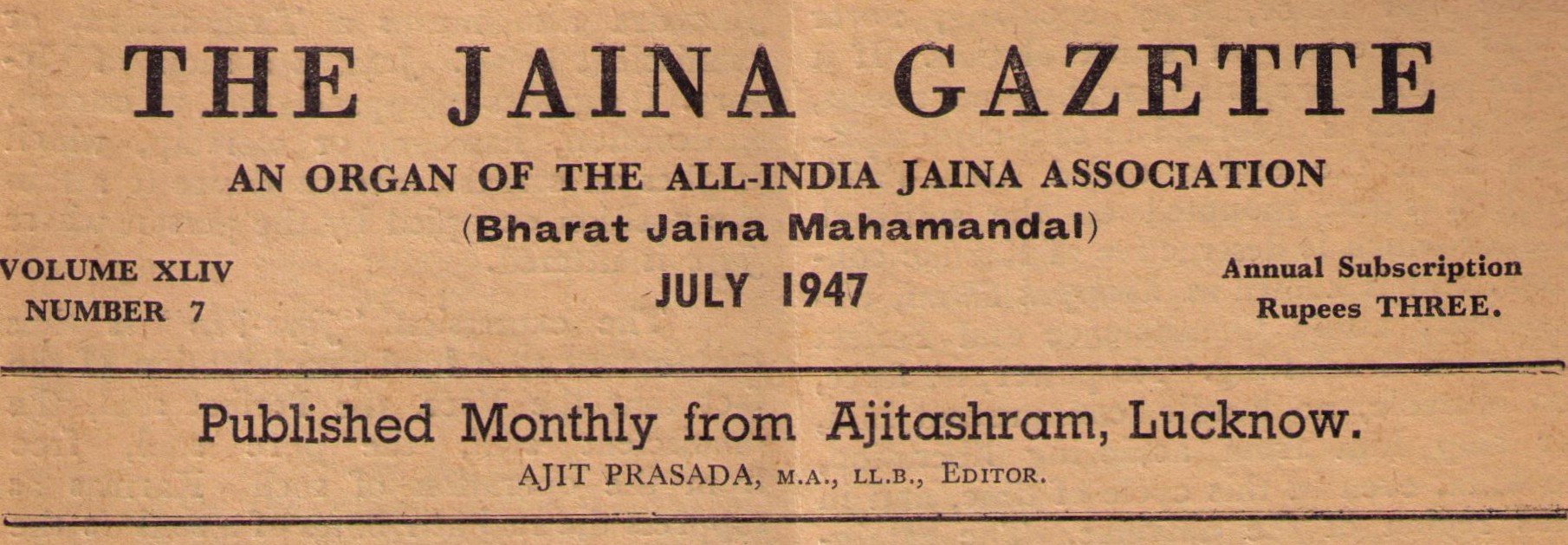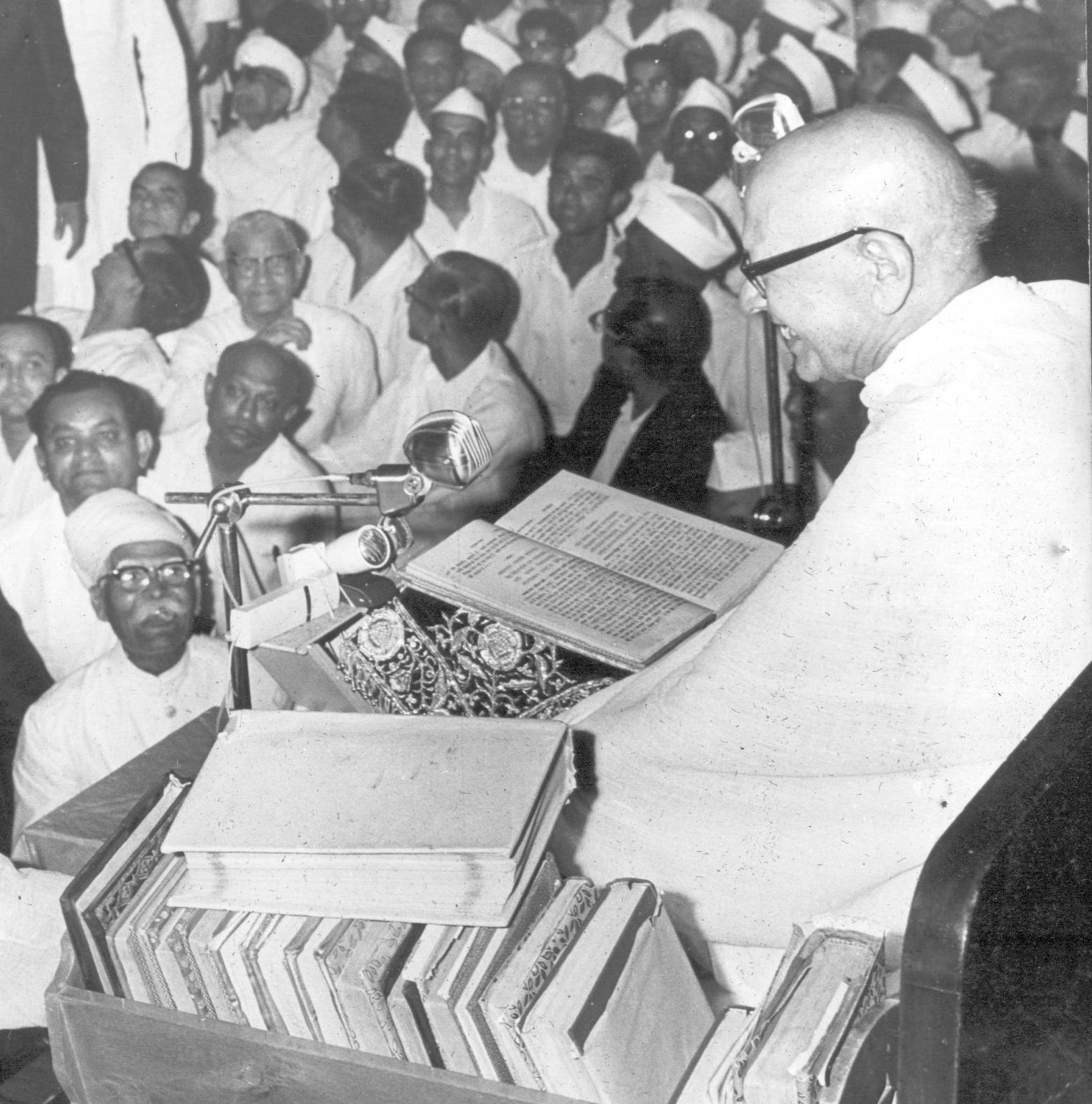
The article describing a lecture given by was first published in July 1947 in The Jaina Gazette (Volume XLIV, Number 7, p. 97-98)
Kanji Swami Maharaj Speaks (I)
The saint of Songadh has in a discourse exposed some prevalent fallacies, which have warped the views, and restricted the progress of Jains and Jainism.
He says that very many ostensibly devout and religious men believe samyak-darshan, right faith, to mean simply and only the renunciation of attachment to “women, wealth, family and position.” Such renunciation is only a beginning. It is not the end. It is only a step towards attainment of right faith. Bhakti, a sort of attachment to a particular Tirthankara by name, to a particular sacred place, and to a particular ascetic signifies an absence, a lack of right belief. This shade of wrong belief is very commonly prevalent among those who have a reputation for being religious men. It is dangerous because it acts as a bar to further progress, when it would have been helpful if it were only a step towards the goal, and had not acted as the goal, the halting place, the be-all and end-all of all endeavour. A matter of further regret is that such proclivities are not stopped, but are encouraged by religious guides, Gurus, Munis, and Acharyas. The result is a negation of Jainism in practice, a sliding back to the stage of wrong belief, the only difference being that the name of a Tirthankara, or some minor Jain worthy such as Phanindra, Padamavati, Kshetrapal, Bharaiva, or Guru is substituted for Durga, Bhawani, Shakti, Kali, Hanuman, etc.

Kanji Swami in Songadh
The belief has therefore grown strong among religiously inclined Jain householders to offer a silver canopy (chattra) at Mahabirjee Chandangaon in the Jaipur State, a silver swastika at Firozabad, to have a tonsure at Hastinapur, and to celebrate a worship of Shantinath in order to ward off disease, affliction, loss in business or litigation, for success in speculation, in an university or school examination, or other temporal objects. Jainism is thus degraded in practice, and the pure perfect spirits of Tirthankaras are dragged down to the level of the numerous gods of the Hindu pantheon or to that of Muslim saints. Mahavirjee, Hastinapur gain in popularity, and Padmapuries are created as fresh places of pilgrimage.
The present defeatist mentality of the Jains is a serious handicap in the way of all their social, political, and religious progress. It is commonly said and repeated that the attainment of liberation, freedom from the shackles of karma, self-realization, is impossible in the current cycle of time, which is termed pancham kal, and in this part of the universe, which is known as Bharat Kshetra. This belief, though true, is misunderstood, and is not explained or understood in the right perspective. Time and place, truly speaking, never stand in the way of soul-evolution. If it were possible to spirit away, by some means, a saint who is absorbed in soul-contemplation from the region called maha-videh, such a saint, mounted on the spiritual ladder which is destructive of karmic contact, and is known as ksuhapak shreni, will assuredly attain omniscience and perfect freedom everlasting. No power, no force, no obstacle, no hurdle, can prevent him, or stop him from achieving liberation, moksha, even in this cycle of time, and in this region of the universe. The attainment of the goal depends on your own personal will power, your strength of conviction, your determination, and concentrated effort, called purusharth. It is certainly, and admittedly possible, practicable, and not very difficult, even in this time, and in this region to adopt a course of life and conduct which will make the attainment of the goal a certainty in the future.
Samyak-darshan, right belief, is not an impossibility but is attainable in the present time and in the land in which we live. The daily practices observed in private life, and in public temples, and on special religious days and festivals are however not in the right direction. There is show and ostentation of matters foreign to the true spirit of Jainism.
The short and simple words "jaya-veer", "jaya arihant” or "jai jinendra" are fully expressive of the Jain doctrine. Veer, or Mahavir, is the name of the last of the 24 Jain Tirthankaras, or propounders and propagators of faith. Arihant is an omniscient, and includes a Tirthankara. Jinendra also means a Tirthankara or omniscient being. Jaya is a shout of victory. It signifies an appreciation, an esteem, a devotion, homage, or worship, which implies an earnest, intense desire to attain the position occupied by the person whose jaya is uttered.
The expression “jaya-veer” is thus tantamount to a loud, proclamation of the fact that the veer, the Perfect soul, the omniscient soul, the pure soul, free from the operation of such karmas as suppress the real attributes of a soul is the worshipful condition, the adorable status, the goal, which is in view, which the utterer of the expression wishes to acquire. It shows an implicit belief that the soul is capable of becoming pure and perfect, and becoming so, through its own exertion, independently of any help or favour, from anybody else. It is a negation of any other agency than its own self. It implies a firm faith in the eternal, uncreated, existence of the soul as an established fact, its existence in an impure state, contaminated by particles of matter of the karmic variety, beyond cognisance of the senses. It also implies an innate possession of infinite attributes of perfection and purity, which are capable of being evolved by self-exertion. It has however been reduced in practice to a mere form of salutation, a social etiquette, a society badge, a term of recognition, and is used as such in epistolatory correspondence, and is a friendly greeting. The reality is clouded by formality.